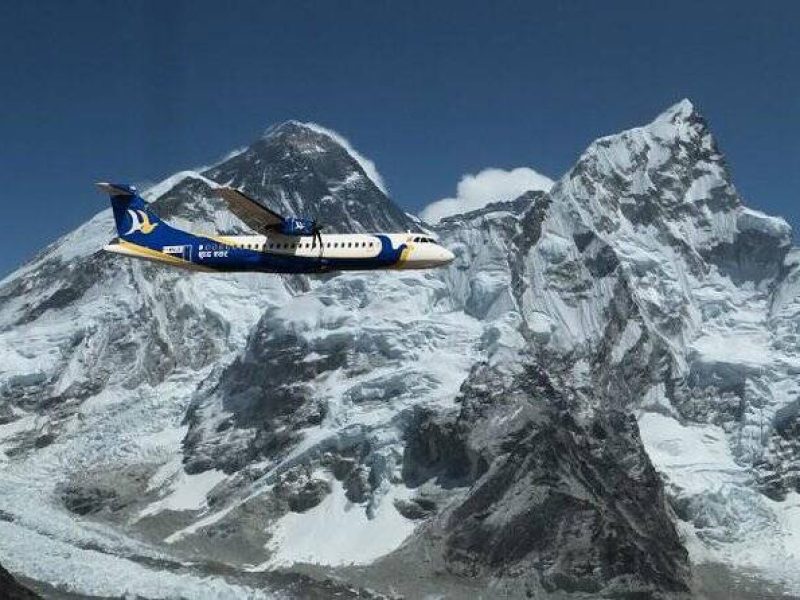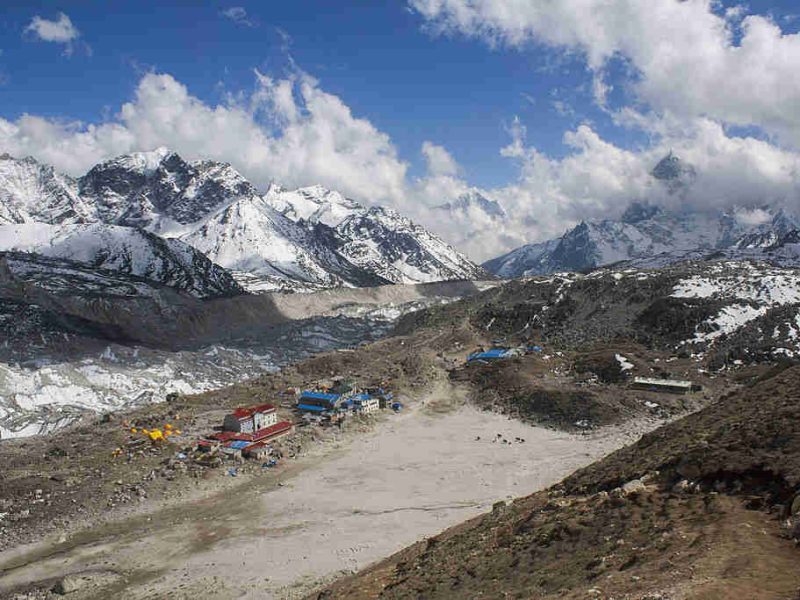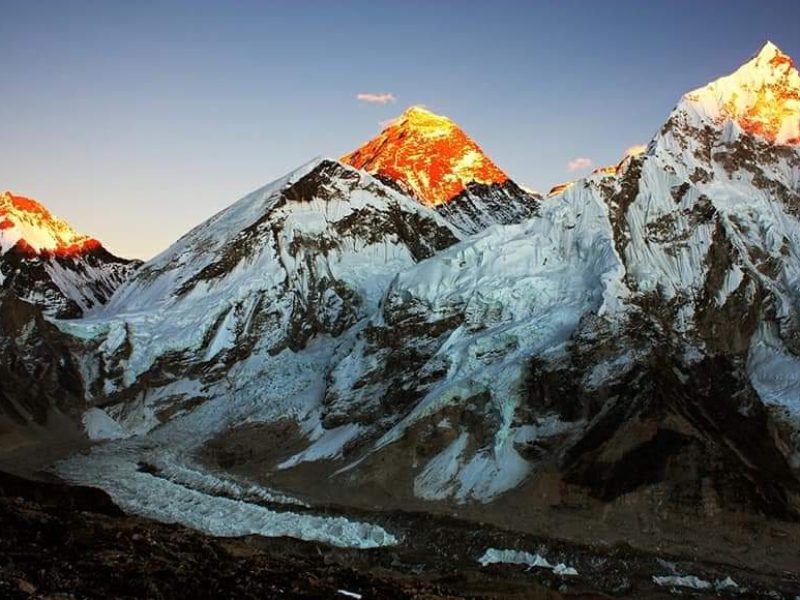Kala Patthar is an amazing place within the Everest Base Camp. Visitors can enjoy the trekking venture from here. They also get to experience a pleasing panoramic view of Mount Everest, Mt. Lhotse, Mt. Nuptse, Mt. Amadablam, and other elevations.
Standing at an altitude of 5,644m in the Khumbu region, Kala Patthar is the most popular landmark due to its feasible route, which does not require special technical climbing skills. One can be part of the hiking route with moderate-to-high fitness and endurance.
How Can You Reach Kala Patthar?
Kala Patthar means “Black Rock” in Nepali and connects with the rich history and exploration of nature, which are intertwined with the essence of nature and adventure. Reaching the summit involves trekking. However, the journey begins with a flight from Kathmandu by plane, followed by trekking from Lukla.
Plane Flight To The Himalayan Summit
You can take a flight from Tribhuvan International Airport to the destination location of Tenzing-Hillary Airport, Lukla. The flights to Lukla from Kathmandu need to take off early in the morning to avoid dangerous winds in Lukla, so flights mainly operate from 6:30 a.m. to 9:30 a.m.

Thus, one can catch the morning flights. During the approximately 30- to 40-minute flight duration, tourists could enjoy the scenic flight over the Himalayas. This offers breathtaking views of snow-capped peaks and the challenging, thrilling airstrips of Lukla.
After arriving at Lukla, the trekking route begins, and the first stop will be Phakding.
Road Journey Through Mountain Majesty
If the visitor’s preference is road travel over flying to Lukla, an effective alternative is to drive from Kathmandu to Jiri or Salleri. One can take a jeep or bus. It takes about 8–10 hours to reach Jiri, located in the Dolakha, and 12–14 hours to reach Salleri, situated in the Solukhumbu district.
After that, trekking from Jiri or Salleri to Lukla brings us one step closer to the Kala Patthar summit. Generally, it takes about 5-7 days to reach Lukla from Jiri and 3-4 days from Salleri.
Trail Route To Everest’s Height
Now comes the common route to descend towards the Kala Patthar elevation, i.e., trekking from Lukla. The Kala Patthar trek initiates in Lukla and marks the first stop in Phakding, which generally takes 3 to 4 hours. Next is the beautiful town area in the Himalayas, Namche Bazaar, which marks 6-7 hours.
The route of Namche Bazaar leads the trekkers to Tengboche and then to Dingboche, accumulating almost 12 hours of walking. After that, the Kala Patthar trek map marches towards Lobuche and continuously to Gorak Shep and Everest Base Camp.
![]()
Similarly, Gorak Shep leads the trekkers to the main destination of the trek, Kala Patthar, at an elevation of 5,644 m above sea level. Reaching there accelerates the visitors’ excitement to the point that they completely forget the tiring journey.
The trek to Kala Patthar mainly takes place on the next day after reaching it to avoid afternoon wind and harsh climatic conditions. The returning route follows the same pattern, from Kala Patthar to Namche Bazaar and finally to Lukla.
The Charm Of Kala Patthar Above the Clouds
While the attraction of the Panoramic Himalayan mountains and the sight of Mount Everest are undeniable highlights of Kala Patthar, the charm for tourists extends far beyond. En route to Kala Patthar and throughout the trek, travelers find themselves enveloped in the natural beauty, rich culture, and awe-inspiring vistas of the Nepalese Himalayas.
1. Close-up Views of Everest: Kala Patthar offers one of the closest and most awe-inspiring views of Mount Everest (8848m), the world’s highest peak. Tourists are drawn to the opportunity to witness this iconic mountain from such a vantage point.
2. Panoramic Himalayan Vista: The summit provides a breathtaking panoramic view of the entire Everest region, including neighboring peaks like Lhotse, Nuptse, and Changtse. This panorama is a photographer’s delight and a memorable sight for visitors.
3. Sense of Achievement: Climbing Kala Patthar, which stands at 5,545 meters (18,192 feet), is often part of the Everest Base Camp trek or other Himalayan treks. The challenge and accomplishment of reaching this height contribute to its charm.
4. Cultural and Natural Richness: Beyond the mountains, Kala Patthar offers glimpses into Sherpa culture, local flora, and fauna. It’s an opportunity for tourists to immerse themselves in the natural beauty and unique heritage of the Everest region.
5. Spiritual and Inspirational Experience: Many visitors find Kala Patthar to be a deeply moving and spiritual place. The serene atmosphere and the proximity to Everest create a sense of wonder and inspiration, leaving a lasting impression on those who make the journey.
Apart from these, along the trek route to Kala Patthar Tengboche, Dingboche, and Pangboche, trekkers can enjoy Buddhist festivals and Tibetan culture and participate in popular festivals like Mani Rimdu, Dumji, Losar, and Buddha Jayanti.
Stories Of Everest Kala Patthar’s Historic Ascent
The history of Kala Patthar dates back to the early days of Everest exploration. It emerged as a famous landmark during the pioneering expeditions to conquer the world’s highest peak. The locals named it Kala Patthar, depicting the physical aspects of the place as rugged terrain and formidable nature.
The place played a significant role in the exploration of the Everest region. It was during these expeditions that it emerged as a notable landmark. The mountain has witnessed some of the most memorable moments in mountaineering history, including the historic ascent of Everest by Sir Edmund Hillary and Tenzing Norgay in 1953.

As they made their way towards the summit, Hillary and Norgay passed by the track, noting its imposing silhouette against the backdrop of the Himalayas.
Furthermore, the popularity of mountaineering skyrocketed at that time. The Everest Base Camp Trek started in the early 1950s, and since then, the process has continued, creating history and maintaining a legacy.
For a long time, “Black Rock” has been the place where thousands of stories, victories, disguises, and journeys of life are shared with mountains and nature, as witnessed by the wide sky.
Kala Patthar And Its Role As A Natural Gazing Deck For Mount Everest
The main attraction of Kala Patthar is the stunning and close-up view of the tallest mountain in the world, Mt. Everest. Yearly, about 40,000 people visit Everest Base Camp, and almost all of them take the route of the Kala Patthar trek to experience the panoramic views of Mount Everest.
The palace serves as a natural view tower without the need for technical climbing. Visitors often consider reaching the Kala Patthar as the climax of the journey, as it provides a rewarding visual experience of Everest and the surrounding peaks, which are barely seen through the base camp.
The views of several peaks, including Everest, are often clearer and more comprehensive than those from Everest Base Camp itself. From Kala Patthar, trekkers can see the south face of Everest, which is extraordinarily beautiful and serves as the essence of nature.
The Ever-Changing Climate Of Kala Patthar
Situated about 5,500m above sea level, the temperature is full of roller coaster rides, and climatic ups and downs are common there. On the trekking route, Gorak Step has the most unpredictable climate. Thus, visiting in the appropriate environment is the best.
The most favorable climate in which to enjoy the full journey is autumn and spring, as the route is clear and the temperature is also bearable. However, if you love the adventure, you could be there in the winter and summer seasons to delve into the most thrilling experience through rain and snow.

The temperature during the winter stays around -20 degrees, with most days covered in snow. Likewise, in the summer season, the temperature rises to 10 to 20 degrees. However, fluctuation in the temperature is common, and people might encounter heavy rains, winds, snow, and cold storms occasionally. Thus, proper preparation is needed.
Struggles With Altitude On The Path To Kala Patthar
Being at a high altitude with the frequent fluctuation of climate, it is obvious to experience altitude sickness. The decreased availability of oxygen at the high elevations of 5,644 m causes symptoms like headaches, nausea and vomiting, dizziness and lightheadedness, and fatigue.
When such symptoms are marked on trekkers for some time, they feel like quitting halfway when the destination is just before their eyes. Thus, the primary prevention for altitude sickness includes gradual ascent, hydration, medication, and light physical exercise.
Simple pre-information about the altitude and prevention preparation could be a better way to block the obstruction.
Smart Tips For Comfortable Travel Preparation For Kala Patthar
Before starting the adventurous journey, there are some tips for a better experience and sweet memories:
- Physical Fitness: Good physical condition is essential throughout the trek. Due to the high altitude and long trekking days, physical health might be affected; thus, special care and importance should be given to physical health.
- Acclimatization: The process of adjustment to the new environment is necessary, and the cold and harsh climate requires such time. To prevent altitude sickness, trekkers are required to follow a gradual ascent and include acclimatization days.
- Gear: Proper trekking gear includes thermal clothing, good hiking boots, sleeping bags, and other essentials for cold weather.
- Permits: Sagarmatha National Park Permit and Trekker’s Information Management System (TIMS) card are required to start Kala Patthar’s journey.
- Research: Planning and research before visiting a place are necessary; thus, thoroughly research the place and prepare beforehand to prevent adversity.
The Calming Nature Of The Kala Patthar Trek
Thousands of domestic and foreign trekkers visit the Black Rock trekking route to view the summit. One of the domestic visitors described the journey as the Soul Soothing Trek and exclaimed that the 12-day journey taught about mountains, challenges, inspiration, and transforming oneself.

The visitor also suggests that if you feel the mountains calling, you must go. Similarly, a foreign-renowned journalist, Siobhan WarWicker, mentioned that the sense of achievement and spirit went high throughout the journey, and eventually, small pleasures turned into enormous ones.
Moreover, people of all age ranges have experienced the adventure of the Kala Patthar trek. Two-year-old Carter Dallas from Scotland is the youngest person to have been there as of early 2024, and 80-year-old Yuichiro Miura is the oldest person to have been there.
Frequently Asked Questions (FAQS)
1. What is the age limit for the Trek journey?
There is no exact restricted age limit for the trek, but the advisable age limit for the Everest Base Camp trek is at least ten years old. The age limit is for health concerns and safety.
2. Where is Kala Patthar located, and how high is it?
It is situated near the Everest Base Camp on the southern ridge of Pumori in the Nepalese Himalayas and at an altitude of 5,644 m above sea level.
3. How long does it take to complete the trek?
The duration of the trek can vary depending on the route and itinerary chosen. Generally, it takes around 12–14 days for a complete trek.
4. What is the best time to visit Kala Patthar?
The best time to trek is during the spring (March to May) and autumn (September to November) seasons, when the weather is generally stable and views are clear.
5. What should I pack before visiting Kala Patthar?
Essential items include trekking gear (boots) and warm clothing, a sleeping bag, personal medications, toiletries, snacks, and a camera. It is important to pack light but carry enough layers for varying temperatures.
6. Can I do the Kala Patthar trek independently?
While it is possible to trek independently, many trekkers prefer to go with a licensed guide or through a trekking agency for logistical support, local insights, and safety reasons.
7. What is the total expenditure for visiting Kala Patthar?
Well, it depends on each agency’s packages, the duration of the trek, and the total coverage during the journey. It is better to consult the respective agency for detailed information.

Comment (0)